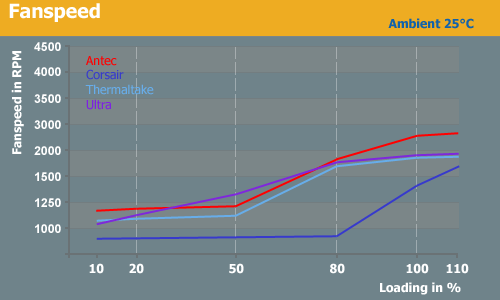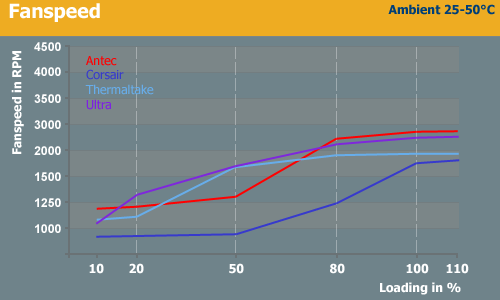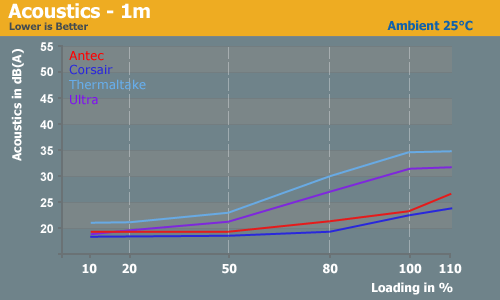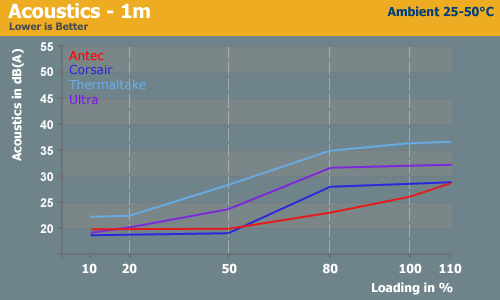400-450W PSU Roundup
by Christoph Katzer on November 6, 2007 4:00 AM EST- Posted in
- Cases/Cooling/PSUs
Comparison
With the four power supplies tested today, we can get a basic idea about the products in the market. Unfortunately, this is a market where higher quality power supplies are getting rare since 500W is the lower end for most companies. A few good manufacturers make 400W and maybe sometimes 350W models, but with many graphics cards "requiring" 500W and higher power supplies marketing has definitely moved to less reasonable units. Rather than creating a good quality 350W power supply, most manufacturers are more interested in attaching a few more cables, adding a couple more components, and selling a 500W (or higher) power supply.
Seasonic is one of the few companies that continue to cater to this market, so it's not too surprising that in addition to their own brand they are also the production facility for the Earthwatts and Corsair power supplies. Staying with Seasonic, however, the M12II series will come out soon and Seasonic wants to start the series at 500W -- just as they did with the first M12 series. That leaves Maxpoint as one of the only remaining companies looking to continue producing lower wattage models.
Despite the marketing hype, many users really have no need for anything beyond a moderate 400W power supply, and perhaps not even that. Consider our results from the GeForce 8800 GT article: with an upper-midrange system, we still topped out at a whopping 327W -- and that's power draw from the wall, not power supply output! Assuming 80% efficiency for the power supply, that particular test system is only using around 260W of power.
As we have seen today, of course, simply going out and grabbing any old 400W power supply might not be a good idea for such a system. While three of the tested power supplies today perform well, we would be very concerned with the prospect of using something like the Ultra 400W. As usual, you get what you pay for. Unfortunately, it seems as though most of the quality power supplies in this range will disappear over the coming year or two, leaving the lower wattage market to cheaper designs that really underperform.
Before we wrap up, let's take a quick look at how the power supplies stack up in a few meaningful areas. We'll start with fan speeds and acoustics.


Corsair clearly has the lowest fan speeds in comparison to the other units. It stays below 1000 RPM until a load of more than 350W is applied. In most actual computers, it will be nearly silent. The other units start to ramp up fan speeds much earlier, which should be not necessary. Corsair keeps the lead even under higher ambient temperatures, despite the fact that the other three power supply fans are spinning 50% faster. Fan speed doesn't really count for noise levels or fan size, however, so let's look at noise measurements.


Comparing the acoustics is interesting because the Antec shows its potential here. The fan turns slightly faster but still produces less noise. Both the Antec and Corsair have a very low noise level and are practically silent. If you're interested in a low wattage, low noise level PSU, Antec and Corsair are definitely worth a look (as well as Seasonic, naturally). The other two power supplies don't do nearly as well. Thermaltake is even louder than the Ultra unit is, even though the fan spins at lower RPMs. Thermaltake should definitely think about changing the fan -- or maybe redesigning the fan grill, heatsinks, or whatever else is necessary -- to bring performance up to the level of Seasonic, et al.
With the four power supplies tested today, we can get a basic idea about the products in the market. Unfortunately, this is a market where higher quality power supplies are getting rare since 500W is the lower end for most companies. A few good manufacturers make 400W and maybe sometimes 350W models, but with many graphics cards "requiring" 500W and higher power supplies marketing has definitely moved to less reasonable units. Rather than creating a good quality 350W power supply, most manufacturers are more interested in attaching a few more cables, adding a couple more components, and selling a 500W (or higher) power supply.
Seasonic is one of the few companies that continue to cater to this market, so it's not too surprising that in addition to their own brand they are also the production facility for the Earthwatts and Corsair power supplies. Staying with Seasonic, however, the M12II series will come out soon and Seasonic wants to start the series at 500W -- just as they did with the first M12 series. That leaves Maxpoint as one of the only remaining companies looking to continue producing lower wattage models.
Despite the marketing hype, many users really have no need for anything beyond a moderate 400W power supply, and perhaps not even that. Consider our results from the GeForce 8800 GT article: with an upper-midrange system, we still topped out at a whopping 327W -- and that's power draw from the wall, not power supply output! Assuming 80% efficiency for the power supply, that particular test system is only using around 260W of power.
As we have seen today, of course, simply going out and grabbing any old 400W power supply might not be a good idea for such a system. While three of the tested power supplies today perform well, we would be very concerned with the prospect of using something like the Ultra 400W. As usual, you get what you pay for. Unfortunately, it seems as though most of the quality power supplies in this range will disappear over the coming year or two, leaving the lower wattage market to cheaper designs that really underperform.
Before we wrap up, let's take a quick look at how the power supplies stack up in a few meaningful areas. We'll start with fan speeds and acoustics.


Corsair clearly has the lowest fan speeds in comparison to the other units. It stays below 1000 RPM until a load of more than 350W is applied. In most actual computers, it will be nearly silent. The other units start to ramp up fan speeds much earlier, which should be not necessary. Corsair keeps the lead even under higher ambient temperatures, despite the fact that the other three power supply fans are spinning 50% faster. Fan speed doesn't really count for noise levels or fan size, however, so let's look at noise measurements.


Comparing the acoustics is interesting because the Antec shows its potential here. The fan turns slightly faster but still produces less noise. Both the Antec and Corsair have a very low noise level and are practically silent. If you're interested in a low wattage, low noise level PSU, Antec and Corsair are definitely worth a look (as well as Seasonic, naturally). The other two power supplies don't do nearly as well. Thermaltake is even louder than the Ultra unit is, even though the fan spins at lower RPMs. Thermaltake should definitely think about changing the fan -- or maybe redesigning the fan grill, heatsinks, or whatever else is necessary -- to bring performance up to the level of Seasonic, et al.










37 Comments
View All Comments
Christoph Katzer - Tuesday, November 6, 2007 - link
Yup and before the use of very bulky heatsinks made the power supplies heavier. Today the components are better and the heatsinks are getting smaller again (Seasonic and FSP standard design for example).Pale Rider - Tuesday, November 6, 2007 - link
It's easily the best of the "lower" power choices.JarredWalton - Tuesday, November 6, 2007 - link
We already reviewed the Seasonic 330W and 500W, and given that Seasonic is the ODM of the Corsair and Antec units... except while Corsair is basically identical to the Seasonic model, Antec messed around with the fan to cut costs or something. 430W S12II and 450VX are pretty much the same PSU.Modular - Tuesday, November 6, 2007 - link
Page 2: "360W combined equates to 15A when both are "fully" loaded."-Should read 30A fully loaded.
Page 5: "The original design used two 17A 12V rails (as does the Earthwatts)"
-Per this review http://www.jonnyguru.com/review_details.php?id=51&...">http://www.jonnyguru.com/review_details.php?id=51&... the Earthwatts line isn't really 2 12v rails either. No biggie, but just wanted to clarify.
The Ultra is listed as a V-Series when it's actually the XVS, which is basically a step above the V-Series in that it has the flex cables and is modular.
Overall this was a pretty informative review. I'm glad that you included heat sink temps and fan noise, and it's really good to see the ripple included.
drebo - Tuesday, November 6, 2007 - link
In the retail computer sales business, I don't consider a $60 430W power supply to be a "Budget" power supply. That's more of a midrange, and is generally overkill for most of the computers sold. Even the Ultra is too expensive to bother with for most of my customers.I'd like to see a true budget roundup. Powersupplies in the $20-30 range. Like those from Athenatech or Maxtop(Q-Max) or even the lower-end Thermaltakes. I realize that they're going to be pretty crappy results, but I think it's important to see, comparitively, how they do. If it were up to me, all of my customers would be using Antec EarthWatts power supplies, but they don't understand why the extra money is necessary. With information like this, it would be far easier to convince them to spend the extra $20.
magreen - Tuesday, November 6, 2007 - link
I second that call for lower cost PSU roundups. I was under the impression that FSP makes decent enough PSUs. Can you include reviews of their 350W, 400W and 450W models? They won't have active PFC, but let's be honest, most users don't care at all about that.Iger - Tuesday, November 6, 2007 - link
+1 actually. I'd really like to understand what kind of performance can one expect from a low-end psu. Then again, Ultra probably answers the question, at least vaguely. I just wish we'd have a bigger choise of psus in europe... And better prices <sigh>Christoph Katzer - Tuesday, November 6, 2007 - link
No choice in Europe? Which country are you living in? Most shops are sending the stuff all around Europe already and you'll probably find even more in Ebay.The problem with a low end PSU roundup is that I am living in Europe as well and it will not be easy to convince a company to send me their stuff when the shipping is triple the cost of the actual product. But let us find a way and in the beginning of next year we will see what we can do...
xsilver - Wednesday, November 7, 2007 - link
Also, has it been investigated whether there are differences between varying PSU's coming off the assembly line?I would like to think that the high end manufacturers could produce identical products but Im not so sure the QC of the cheapo PSU's will give u the same PSU every time. eg. some cheap psu's seem to live on through torrid abuse and yet some just die only after 1 month of use.
Super Nade - Tuesday, November 6, 2007 - link
Hi,Why did you guys cut down on the internal component analysis? Hate to see a single picture and a few cursory words about the internal architecture. Load testing aside, I find everything else a bit boring. You had a nice thing going looking at the components, why cull it? If you decided to shorten the reviews, you could have trimmed the part about acoustics. ;)
Regards,
Super Nade
OCForums